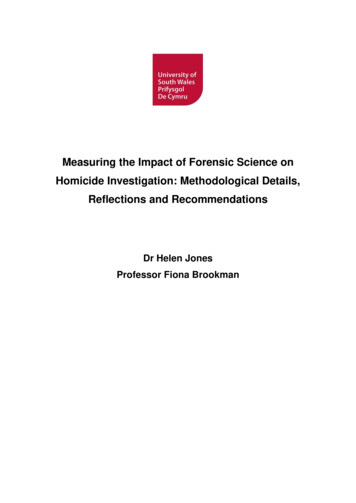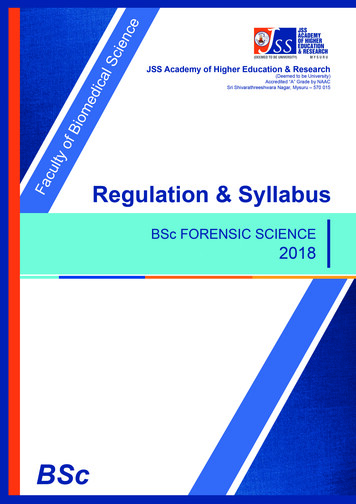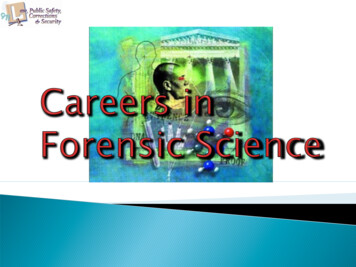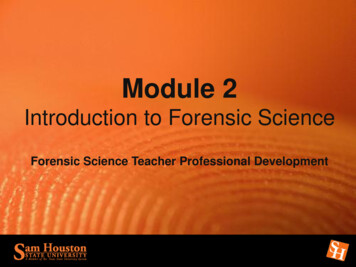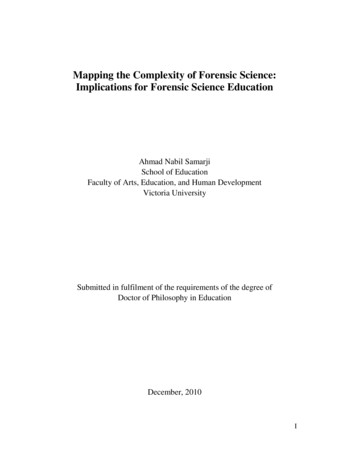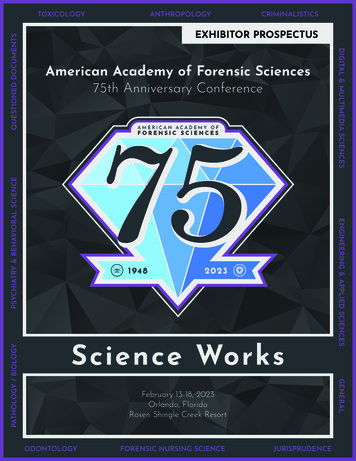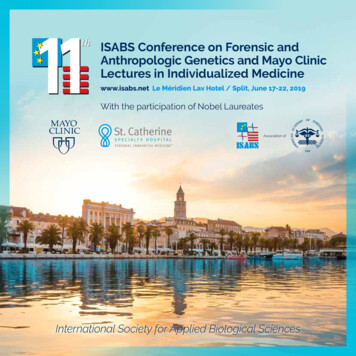
Transcription
ISABS Conference on Forensic andAnthropologic Genetics and Mayo ClinicLectures in Individualized Medicinewww.isabs.net Le Méridien Lav Hotel / Split, June 17-22, 2019With the participation of Nobel LaureatesAssociation ofInternational Society for Applied Biological Sciences
Dear Colleague,We invite you to join us at the 11th ISABS Conference on Forensic andAnthropologic Genetics and Mayo Clinic Lectures in IndividualizedMedicine, Split, Croatia, June 17 – 22, 2019. The conference is next inthe series of biennial events organized by the International Society forApplied Biological Sciences (ISABS), a society dedicated to the promotionof applied molecular biology and genetics (www.isabs.hr).The ISABS conferences have evolved significantly since the inauguralmeeting in 1997. At first, the focus was on the application of cuttingedge DNA analysis methods in forensic science. In 2007 we broadenedthe area of interest by introducing of molecular anthropology, which,in large part, shares its methodology with forensic genetics. In 2009,we introduced selected topics from individualized medicine, anotherapplied discipline based on the mapping of the human genome. Furthercapitalizing on the “genomic revolution”, in subsequent conferences weincluded analysis of plant and animal DNA for the purpose of forensictesting, the importance of DNA databases in the discovery of criminaloffenders, research on the origin of nations, and DNA-based identificationof mass disaster victims. The 10th ISABS conference in 2017 marked abreakthrough towards regenerative medicine and microbiome analysisin forensics, anthropology and medicine.As personalized/individualized/precision medicine was becominga scientific field of its own, the involvement of Mayo Clinic providedthe ISABS conferences with an opportunity to integrate cutting-edgeclinical application of genetics with forensic and anthropologic geneticsand facilitate cross-fertilization among these disciplines. This excellentcooperation continues this year with Mayo Clinic Short Course onEpigenomics.Several years ago ISABS and the American Academy of Forensic Sciences(AAFS) agreed to forge scientific and academic ties to provide educationaland networking opportunities for budding scientists. In the more than70-year-long history of the AAFS, this is only the second such partnership.The collaboration between ISABS and AAFS will be highlighted in thespecial session “AAFS at ISABS” at this year’s conference.2
Program directors Manfred Kayser and Tamás Ördög have prepared anextremely exciting and rich scientific program which, following ISABStraditions, will include lectures by several Nobel Laureates. Following itspremiere at the last conference in Dubrovnik, the Nobel Spirit session willtake place for the second time and will again be broadcast throughoutthe world.It would not be possible to have this conference without the enthusiasmand dedication of our loyal sponsors and invited speakers, all undisputedleaders of their respective fields. We want to express our sincere, heartfeltgratitude to them all!As always, the conference is structured to allow close interaction betweenthe international faculty and attendees. In addition to the scientificsessions, there will be many less formal events and other opportunities tofacilitate networking and forging collaborations, as well as to introducethe participants to the city of Split, a destination famous for its unspoilednature and cultural, historic and sporting attractions.We invite you to Split and its Diocletian’s Palace, seventeen centuries old,yet swarming with contemporary life. Discover and enjoy the beautiesof Croatia, the mild climate, the crystal clear and warm sea, beautifulbeaches, virgin nature, and the rich history and cultural heritage. And,above all, enjoy Croatia’s warm and friendly people.We invite you to Split and Diocletian’s Palace, seventeen centuries old,yet swarming with contemporary life. Discover and enjoy the beautiesof Croatia, the mild climate, the crystal clear and warm sea, beautifulbeaches, virgin nature, and the rich history and cultural heritage. And,above all, enjoy Croatia’s warm and friendly people.Dragan PrimoracMoses SchanfieldStanimir Vuk-PavlovićConference Founders3
Nobel Spirit 2019At the 11th ISABS Conference in Split in 2019, Nobel Spirit will takeplace for the second time. Three Nobel Laureates will participate inthe discussion on medicine and society of the 22nd century: prof.Avram Hershko (Technion, Israel), prof. Robert Huber (Max PlanckInstitute of Biochemistry, Germany) and prof. Paul Modrich (DukeUniversity, USA).Topics for 11th ISABS ConferenceForensic Genetics:Genome-based applications in forensic scienceForensic DNA phenotypingForensic DNA databasesGenetic analysis of forensic non-human materialForensic and comparative geneticsDNA analysis in victims of mass disastersLegislation pertinent to DNA databasesDNA autopsy in unexplained deathsAnthropological Genetics:Ancient DNAMigration historyGenetic adaptation4
Medical Genetics:Genetic basis of diseasePersonalized genomicsMolecular diagnostics: current technology and applicationsMolecular therapyBest practices in translational & personalized medicinePrenatal diagnosticsProtein glycosylation in diagnostics and therapyRegenerative medicineTranslational medicineCell therapyGene therapyStem meLiquid biopsyIndividualized (Personalized) medicineImmunotherapyInfectious diseasesContact Information:International Society for Applied Biological Sciences – ISABSHondlova 2/11, 10 000 Zagreb, CroatiaWeb: www.isabs.hrE-mail: info@isabs.hr5
11th ISABS Conference Invited speakers:Nobel Lectures:Avram Hershko (Nobel Prize in Chemistry 2004, The Technion-Israel Institute ofTechnology, Haifa, Israel)Robert Huber (Nobel Prize in Chemistry 1988; Max-Planck-Institute, Martinsried,Germany)Paul Modrich (Nobel Prize in Chemistry 2015, Duke University Medical Center,Durham, NC, USA)Individualized Medicine Program:Ryan C. Bailey (University of Michigan, Ann Arbor, MI, USA): Microfluidic tools forautomating epigeneticsArnold Caplan (Case Western Reserve University, Cleveland, OH,USA): Mesenchymal Stem cells: time to change the nameLuis A. Diaz, Jr. (Johns Hopkins University, Baltimore, MD, USA): Clinicalapplications of circulating tumor DNAHenry A. Erlich (Children›s Hospital Oakland Research Institute, Oakland, CA,USA): Next-generation sequencing for non-invasive prenatal diagnosis of thehemoglobinopathies: a model for autosomal recessive diseasesNilufer Ertekin-Taner (Mayo Clinic, Jacksonville, FL, USA): Comparative – omics inneurodegenerative diseases: pathways of convergence and divergenceMagnus Essand (Uppsala University, Uppsala, Sweden): Cancer immunotherapyusing genetically engineered viruses and immune cellsMark A. Frye (Mayo Clinic, Rochester, MN, USA): Genetics of bipolar diseaseHaojie Huang (Mayo Clinic, Rochester, MN, USA): Gene mutation, epigeneticremodeling and therapy resistance in cancerWolfgang Janni (Ulm University, Ulm, Germany): Clinical utility of circulatingtumor cells in early and advanced breast cancerManolis Kellis (MIT Computer Science and Artificial Intelligence Laboratory,Massachusetts Institute of Technology, Cambridge, MA, USA and The BroadInstitute of MIT and Harvard, Cambridge, MA, USA): From genomics to therapeutics:uncovering and manipulating the genomic circuitry of human diseaseJohn B. Kisiel (Mayo Clinic, Rochester, MN, USA): Liquid biopsy for early detectionof cancer: recent advances and key challenges6
Eric Klee (Mayo Clinic, Rochester, MN, USA): The use of multi-omics to resolveundiagnosed rare disease patientsGordan Lauc (University of Zagreb; Genos Ltd., Zagreb, Croatia): The HumanGlycome Project - Exploring the new frontier in personalised medicineMinetta Liu (Mayo Clinic, Rochester, MN, USA): Development of circulatingtumor cell- and cell-free-DNA-based assays for the management of solidtumorsRaul Mostoslavsky (Massachusetts General Hospital Cancer Center;Harvard Medical School, Boston, MA, USA): Linking cancer, epigenetics andmetabolism: lessons from SIRT6Grzegorz S. Nowakowski (Mayo Clinic, Rochester, MN, USA): Therapyof aggressive B-cell lymphoma – aligning alterations into pathways andpathways into therapeutic targetsTamas Ordog (Mayo Clinic, Rochester, MN, USA): Interrogating andmanipulating lineage-critical enhancers for therapeutic benefitDragan Primorac (The Pennsylvania State University and University of NewHaven, USA; St. Catherine Hospital, Children›s Hospital «Srebrnjak», Zagreb,Croatia; Universities of Split, Rijeka and Osijek, Croatia): Articular cartilageregeneration: current and future technologiesKeith D. Robertson (Mayo Clinic, Rochester, MN, USA): Identifying andtargeting epigenetic defects in liver diseaseJacques Schrenzel (Geneva University Hospital, Geneva,Switzerland): Microbiome analysis in clinical medicine: hope or hype?Keith Stewart (Mayo Clinic, Rochester, MN, USA): Genome-informedmedicine 2019Christoph A. Thaiss (Perelman School of Medicine, University of Pennsylvania,Philadelphia, PA, USA): Microbiome dynamics in metabolic diseaseRaul Urrutia (Medical College of Wisconsin, Milwaukee, WI,USA): Epigenomics of pancreatic cancerGeorge Vasmatzis (Mayo Clinic, Rochester, MN, USA): Personalized therapymonitoring and relapse detection strategies using abnormal tumor-relatedDNA junctionsRichard Weinshilboum (Mayo Clinic, Rochester, MN, USA): Genes and drugresponse: an Odyssey7
Andre van Wijnen (Mayo Clinic, Rochester, MN, USA): Epigenetics of skeletaldevelopment and mesenchymal stem cell differentiationRugang Zhang (The Wistar Institute, Philadelphia, PA, USA): Approaches toSWI/SNF alterations in cancerZhiguo Zhang (Columbia University, New York, NY, USA): Epigeneticalterations in gliomaForensic Genetics and Anthropological Genetics Program:Joshua Akey (Princeton University, Princeton, NJ, USA): Archaic human DNAin the genome of modern humansFrederick Bieber (Harvard Medical School, Boston, MA, USA): Geneaologics:public DNA databases in forensic investigationJoachim Burger (University of Mainz, Germany): Demographic andevolutionary inference from palaeogenomesYaniv Erlich (Columbia University, New York City, NY, USA): The hitchhiker’sguide to breach genetic privacyTom Gilbert (Centre for GeoGenetics, Natural History Museum of Denmark,University of Copenhagen, Copenhagen, Denmark): Human geneticconsequences of the second plague pandemicWolfgang Haak (Max Planck Institute for the Science of Human History,Jena, Germany): Into the great wide open: 3000 years of human populationhistory in the Caucasus regionBastiaan Heijmans (Leiden University Medical Center, Leiden,Netherlands): Cross-omics analysis in populations to understand the role ofepigenomic change in human ageingMitchell Holland (The Pennsylvania State University, State College, PA,USA): DCMPS of mtDNA heteroplasmy: an established tool for forensicinvestigationsMelissa Ilardo (University of Utah, Salt Lake City, UT, USA): Genetic andphysiological adaptations to diving in modern humansJodi Irwin (Federal Bureau of Investigation, Quantico, VA, USA): MPSimplementation in forensic caseworkMattias Jacobsson (Uppsala University, Uppsala, Sweden): Interrogatingearly human history using ancient DNA from AfricaManfred Kayser (Erasmus MC University Medical Center Rotterdam,Netherlands): Improving forensic Y-STR and Y-SNP analysis8
Michael Kobor (University of British Columbia, Vancouver, Canada):Environmental factors shaping the human epigenomeJohannes Krause (Max Planck Institute for the Science of Human History,Jena, Germany): The genetic history of the Plague: From the Stone Age tothe 18th centuryJames Landers (University of Virginia School of Medicine, Charlottesville, VA,USA): Microfluidics: Science, technology, and applications in forensics andmedicineSimon Mead (University College London Hospitals, London, UnitedKingdom): Genetic adaptation to prion diseases with a particular reference toKuru in Papua New Guinea and CID in EuropeMatthias Meyer (Max Planck Institute for Evolutionary Anthropology, Leipzig,Germany): Improving techniques for the retrieval and analysis of ancienthuman DNALudovic Orlando (CNRS Université de Toulouse, Toulouse, France and Centre forGeoGenetics, Natural History Museum of Denmark, University of Copenhagen,Copenhagen, Denmark): From short, degraded, ancient DNA molecules togenome-wide epigenetic signatures: exploring our epigenetic pastWalther Parson (Medical University Innsbruck, Innsbruck,Austria): Development and validation of prototype MPS tools to inferappearance, ancestry and age from forensic DNA samplesDaniele Podini (George Washington University, Washington D.C.,USA): Microhaplotypes: a comprehensive forensic DNA markerNoah Rosenberg (Stanford University, Stanford, CA, USA): Matching DNArecords with disjoint sets of genetic markersAntti Sajantila (University of Helsinki, Helsinki, Finland): Use of human andvirus DNA for assessing ancestry in forensic and archaeological contextAnne Stone (University of Arizona, Tucson, AZ, USA): Tracking a killer: usingancient DNA to understand the evolutionary history of MycobacteriumtuberculosisMark Thomas (University College London, London, United Kingdom): GeneticastrologyZhenjiang Xu (Nanchang University, Jiangxi, China): Accurate estimates of thepost-mortem interval using cadaver-associated microbiomesHwan Young Lee (Seoul National University College of Medicine, Seoul, SouthKorea): Epigenetic age signatures in bones9
There’s no place like Split!Whenever we hear of something dire happening near or far away – be ithurricanes, storms, quakes, floods, volcanoes – we cannot help but recallDiocletian and praise him for his great wisdom in choosing such a fine placefor this city of ours.Were you to take the globe, turn it around, spin it like a whirligig, visit everyplace from the North Pole to the South, from Japan to the Americas, you wouldsee there is nothing so perfectly positioned as this. Ideal in everything. We’vegot it all, all at hand and all close. We’ve got the sea and the islands in front, toshield us from the perilous waves and give us somewhere to build our summerhouses and take excursions.It is not only the sea that we hold dear, but our river as well. River Jadro is notone of those great rivers that run wild and unpredictable, but rather one thatgives us clean water to mix with our wine and wash our eyes of sleep. A placewhere it is oh so nice, when there is a fiesta in small city close to Split, Solin, tosit on the grass and fling lamb bones into the river after delicious meal.In the heart of the Split we have a mountain, and not just any mountain but amost beautiful specimen with the finest peak imaginable. And on this Marjanmountain, woods whose darkness holds secrets of young loves forged, hiddenaway from inquisitive eyes. And though we have the sea and the hills and theriver and the woods, none of them are a menace to us, making us feel wellsheltered instead.As for the climate, we simply can’t complain. We are the sunniest city in all ofEurope. And yet we are in no want of rain, because we have plenty. Every twoor three years a smidgeon of snow falls for our young ones to see. When thesummer becomes too hot to bear, the landward breeze keeps us cool. Thewind bura blows to clear the air. We are in no danger of earthquakes for wedo not have soil of elastic marl that stretches like rubber, and they can do nomore than sway us a little.10
Had we entrusted engineers with drawing such an ideal place on the map, wewould not have got this for they would have forgotten or missed something.After all, it is not in vain that they say: “There’s no place like Split!”And still we complain how expensive everything in Split is! We ought to behappy and keep quiet, for even with no money jingling in our pockets, we areall just by living here - millionaires!Miljenko SmojeCroatian journalist, novelist and travel writerSplit October, 7, 196411
ISABSThe FirstTwenty YearsAbout ISABSInternational Society for Applied Biological Sciences (ISABS) is a non-profit organizationfounded to promote, enhance and extend research, development and education inmolecular biology as applied to clinical and molecular medicine, focusing on, but notlimited to, molecular genetics, genomics, proteomics, forensic and anthropologicalgenetics, and biotechnology. Principal activities of the Society include:· Advancing education in applied molecular biology;· Fostering collaboration with scientific, academic and professional associationsworldwide to facilitate communication and exchange of ideas;· Organizing conferences, seminars, workshops, symposia and lectures locally,nationally and internationally;· Funding short-term and long-term exchanges and visits for education andtraining of outstanding young and senior scientists in prominent institutionsworldwide;· Publishing scientific, educational and position papers, books and manualsfor timely dissemination of relevant information on scientific, technical andpublic policy issues in pursuit of the goals and activities of the Society.MissionTo contribute to the advancement of the biological sciences and applications ofpertinent techniques and technologies by promoting, improving and extendingall aspects of research; technological developments and educational activitiesin the fields of applied biological sciences and related areas and exchangingcutting-edge scientific content among scientists.VisionTo intensify fundamental, applied and translational research. Provide newprofessional, bioethical and humane approaches to applied biological sciencesby valuing new perspectives, opportunities, and supporting the analysis ofideas, practices, research, and technologies. Create collaborative scientificconnections to bridge the gap between the challenges and opportunities ofemerging technologies and applications as well as between diverse needs ofresearchers. Participate in the advancement of educational system activitiesand increase public awareness of applied biological sciences and technologiesand their benefit and overall impact on society.12
LogotypeISABS logo evolved from the logo of the First European-American Intensive Coursein Clinical and Forensic Genetics. It symbolized the link of European Union stars andthe United States flag. As today scientists from more than 70 countries participatein ISABS activities, the logo has been redesigned to memorialize the origins of theSociety and symbolize the connection among scientists all over the world.History of ISABSProf. Dragan Primorac initiated the idea of ISABS at the American Academy of ForensicSciences Annual Meeting in Nashville, Tennessee in February 1996. Prof. MosesSchanfield (George Washington University) joined Dr. Primorac to help organizethe Society right away, followed soon by Prof. Stanimir Vuk-Pavlović (Mayo Clinic).Although the first official assembly of the ISABS was held in 2004, the society actuallystarted in 1997 by organizing The First European–American Intensive Course inPCR Based Clinical and Forensic Testing. This meeting’s aim was to promote scienceand Croatia and has since been organized biennially, leaving a significant impactto the surrounding regions and beyond.Importance of the meetings has grown continuously due to cutting-edge scientificcontent provided by the success in recruiting the most relevant scientific leaders. Since2003, meetings have been organized with participation of Mayo Clinic (Rochester,Minnesota, USA) and University of Zagreb as codified by the Memorandum ofUnderstanding between the two institutions.To expand the scope of the program based on the foundational precept ofapplied genetics, the 2005 Dubronik Conference started including topics inmolecular anthropology. This innovation accentuated the fact that forensic andanthropologic genetics share almost identical analytical technology and manyinterpretational concepts. The good reception of this topic led to the dedicatedsessions first organized in Split in 2007. It was only natural to extend the scopeof the program into cutting–edge topics in molecular medicine. In addition,interesting workshops and satellite symposia were held on prenatal diagnostics,protein glycosylation in diagnostics and therapy, legislation pertinent to DNAdatabases and DNA autopsy in unexplained deaths. To emphasize the role of theSociety in organizing the conference series, ISABS name was introduced into thename of the conference in 2007.Since the first conference in Split in 1997 over 300 lecturers have been deliveredto a cumulative audience of more than 2000 scientists from all over the world.13
ISABS conferences are organized under the auspices of the Croatian Academyof Sciences and Arts.In collaboration with the ISABS for the first time AAFS International EducationalOutreach Program (IEOP) took place in Croatia as well as a joint forensic science panel.ISABS and the American Academy of Forensic Sciences (AAFS) as its sister Academy,agreed to forge scientific and academic ties to provide even more opportunities andaccess for the budding scientists. In more than 70-year-long history of the AAFS, thisis the second such partnership.At the 10th ISABS conference in Dubrovnik, the Nobel Spirit took place for the firsttime and was broadcast throughout the world, being the only such exclusive Nobelevent outside of Sweden.Croatian Medical JournalThe official journal of the International Society for Applied Biological Sciencesis Croatian Medical Journal (CMJ), an international peer reviewed journal opento scientists from all fields of medicine and related research. The CMJ is an openaccess journal that does not levy page charges. It is indexed in all pertinentbiomedical indices. Since 2001, CMJ is dedicating a special issues to the biannualISABS conferences Instructions for authors can be found at (www.cmj.hr) whereyou can access previous journal issues.AwardsAt each conference Young Investigator Award were presented for outstandingresearch presented by investigators under forty. A committee selects finalistsfrom nominees who submit abstracts. In addition to an attractive prize andcertificate, each recipient is given the opportunity for the podium presentationof the winning research.Recipients of the ISABS Young Investigator Award2017 Sabriya Syed, USA (Personalised Medicine)Goran Josipović and Vladimir Zanki, Croatia (Personalised Medicine)Atina Vidaki, The Netherlands (Forensic Genetics)Mateja Hajdinjak, Germany (Anthropological Genetics)2015 Dora Polšek, Croatia (Individualized Medicine)Barbara Zajac, Germany (Forensic Genetics)Niraj Rai, India (Anthropological Genetics)2013 Matko Čančer, Sweden (Gene therapy)Dora Markulin, Croatia (Genome-based applications in forensic science)Branka Gršković, Croatia (Genome-based applications in forensic science)Slavé Petrovski, USA (Personalized genomics)Antoinette Westen, The Netherlands (Genome-based applications in forensic science)14
2011 Rebecca S Just, USA (Genome-based applications in forensic science)Mark Barash, Australia (Forensic DNA phenotyping)Renato Polimanti, Italy (Molecular anthropology)Martina Smolić, Croatia (Molecular therapy)2009 Chiara Barbieri, Germany (Molecular Anthropology)Fernanda Gonçalves, Brasil (Individualized Medicine)Pavlo Tatarskyy, Ukraine (Individualized Medicine)Antoinette Westen, The Netherlands (Forensic Genetics)2007 Grzegorz Kaczmarczyk, Poland (Forensic Genetics)Agnieszka Krzyżańska, Poland (Forensic Genetics)Kaye Ballantyne, Australia (Molecular Anthropology)Tomislav Domazet-Lošo, Croatia (Molecular Anthropology)Coralie Frassati, Switzerland (Molecular Anthropology)Taeko Kashima, Japan (Molecular Anthropology)2005 Caroline Round, United Kingdom (Forensic Genetics)Tracy Johnson, USA (Forensic Genetics)Vedrana Montana, USA (Molecular and Cellular MedicineMirela Baus Lončar, Germany (Molecular and Cellular Medicine)2003 Robert J. Shelton, USA (Forensic Genetics)Chiara Magri, Italy (Molecular and Cellular Medicine)2001 Lucia Cifuentes Ovalle, Chile (Population Genetics)Katja Drobnič, Slovenia (Forensic Genetics)Tomasz Kupiec, Poland (Population Genetics)Rima Dada, India (Molecular and Cellular Medicine)Anna Gareeva, Russia (Molecular and Cellular Medicine)Nguyen Hoai Giang, Vietnam (Molecular and Cellular Medicine)Medal of Merit Award2009 Henry C Lee, USA (For His Outstanding Contribution and Servicein Forensic Science)A High School “Future Scientist Award”(in alphabetical order)2017 Filip Bognar, XV. Gymnasium, Zagreb, CroatiaLovro Jančić, Karlovac Gymnasium, Karlovac, CroatiaRej Kovačević, VII. Gymnasium, Zagreb, CroatiaLara Primorac, XV. Gymnasium, Zagreb, CroatiaMagda Topić, XV. Gymnasium, Zagreb, CroatiaBorna Branimir Vuković, V. Gymnasium, Zagreb, Croatia15
About CroatiaThe Republic of Croatia is located in the heart of Europe at the intersectionof the Mediterranean, Panonnian and Dinaric influences. It’s centralgeopolitical position prompted the rise of populations from the Paleolithicand later prehistoric cultures, through Illyrian tribes, Greeks and Romans,Slavs and Avars, Turks and numerous others leaving an impact on the historyand contemporary character of Croatia.Early Christianization of Croats contributed to their historic role in thedisproportionately large role in the formation and preservation of Westerncivilization. Through many tumultuous centuries Croatia inherited a richmaterial and spiritual heritage, many of which are on the UNESCO list of worldcultural heritage. In fact, Croatia proudly presents the longest list of protectednonmaterial cultural heritage in Europe; worldwide only China, Japan and Koreahave longer lists. Visitors can enjoy the abundant virgin natural beauty amongthe relics of thousands of years of rich history.Croatia offers excitingly different landscapes within a rather small territory.With 1,185 islands and islets, of which 66 are inhabited, and one of the mostindented coastlines in Europe, the Adriatic Sea is undoubtedly a most populartourist destination.16
Previous ISABS Conference Locations·Zagreb, the capital and political, economic, intellectual and cultural centreof Croatia is a vivacious European metropolis with well-preserved centralEuropean charm.·Split, the second largest city in Croatia and the regional capital of Dalmatiawas built inside and around the seventeen centuries old Diocletian’s Palaceand is included in the UNESCO world heritage list.·Dubrovnik, a medieval aristocratic republic from the 12th to the 19th centuryand the best preserved walled city in the Mediterranean which Lord Byronnamed the “pearl of the Adriatic”, is among Croatia’s main tourist attractionsand among only three European cities ranked as a World Heritage Site ofthe highest (zero) category by UNESCO.·Bol is the oldest coastal settlement on the beautiful island Brač. To the westfrom Bol lies the beach Zlatni rat (Golden Horn), one of the largest and mostbeautiful attractions of the Adriatic. Like a small tongue it extends nearlyhalf a kilometer into the clear blue sea.17
1st conferenceSplit, September 23 – October 3, 1997European-American Intensive Coursein PCR Based Clinical and ForensicTestingAbout the ConferenceThe aim of this conference was to enable all colleagues to learn about recentdevelopments in the field of molecular biology, particularly in PCR. The firstweek contained the forensic session. Laboratory work included samplecollection, screening of evidence, different approaches to DNA extractionfrom different tissues, DNA quantification, DNA amplification and detection,STRs and mitochondrial DNA analysis as well as statistical considerations.Additionally, invited lecturers covered different topics in their areas of expertise.The second week contained the clinical session with lectures and laboratorywork including trinucleotide repeat diseases, SSCP analysis, sequencing ofgenomic DNA as well as in situ PCR hybridization. Again, lecturers covered topicsthat included prenatal diagnosis of genetic diseases, screening for mutations,different approaches for gene therapy as well as new diagnostic tools. We alsoorganized a cruise and a field trip to enable informal scientific communicationamong the lecturers and attendees. We introduced Split to all participants asone of the most beautiful cities on the Adriatic Coast that was celebrating itsone thousand seven hundredth birthday.18
Topics/lecturesForensic Genetics:DNA Analysis in Criminal InvestigationThe Role of the Forensic Pathologist in Preservation of DNA EvidenceSearching for Missing and Imprisoned PersonsIdentification of Human Remains from Mass GravesAnalysis of the Mitochondrial DNA in Forensic MedicineIntroduction of the Analysis of Sexual AssaultsSTR Analysis and ApplicationsExperience with AFLP in Forensic CasesMolecular Medicine:Molecular Basis of Genetic DiseasesMolecular Diagnosis, Monitoring and Therapy of CancerFundamentals of the DNA Molecules in Electric Field and Fluorescent DetectionMethodsPCR Analysis of Gene Expression in Rare Cell PopulationsHuman Gene TherapyDetection and Scanning of Mutations and PolymorphismsTransgenes as Markers of Osteoblast Lineage ProgressionFuture Developments in Automated Human Genetic AnalysisImmunotherapy of CancerHistory of Human Genetics in CroatiaNumber of participants150Number of countries1719
2nd conferenceDubrovnik, September 3 –14, 2001European-American Intensive Coursein Clinical and Forensic TestingAbout the ConferenceThe 2001 conference was filled with a combination of progressive scientific talksfrom invited investigators in forensic and clinical medicine, as well as posterpresentations of scientific abstracts.The first part of the intensive course introduced current issues in forensic identitytesting. The clinical section of the conference addressed issues relating genetherapy of cancer and inherited diseas
University, USA). Topics for 11th ISABS Conference Forensic Genetics: Genome-based applications in forensic science Forensic DNA phenotyping Forensic DNA databases Genetic analysis of forensic non-human material Forensic and comparative genetics DNA analysis in victims of mass disasters Legislation pertinent to DNA databases DNA autopsy in .

